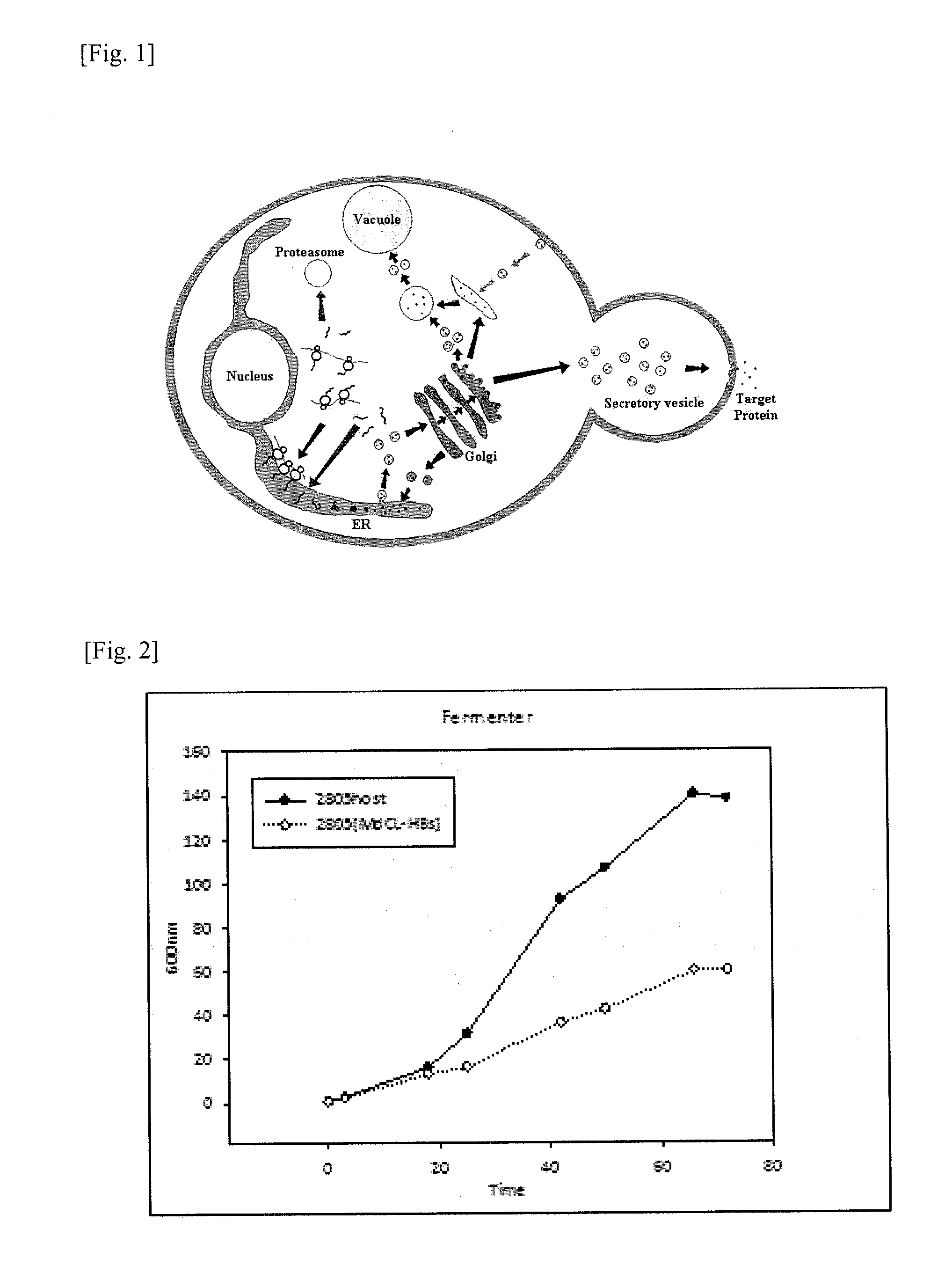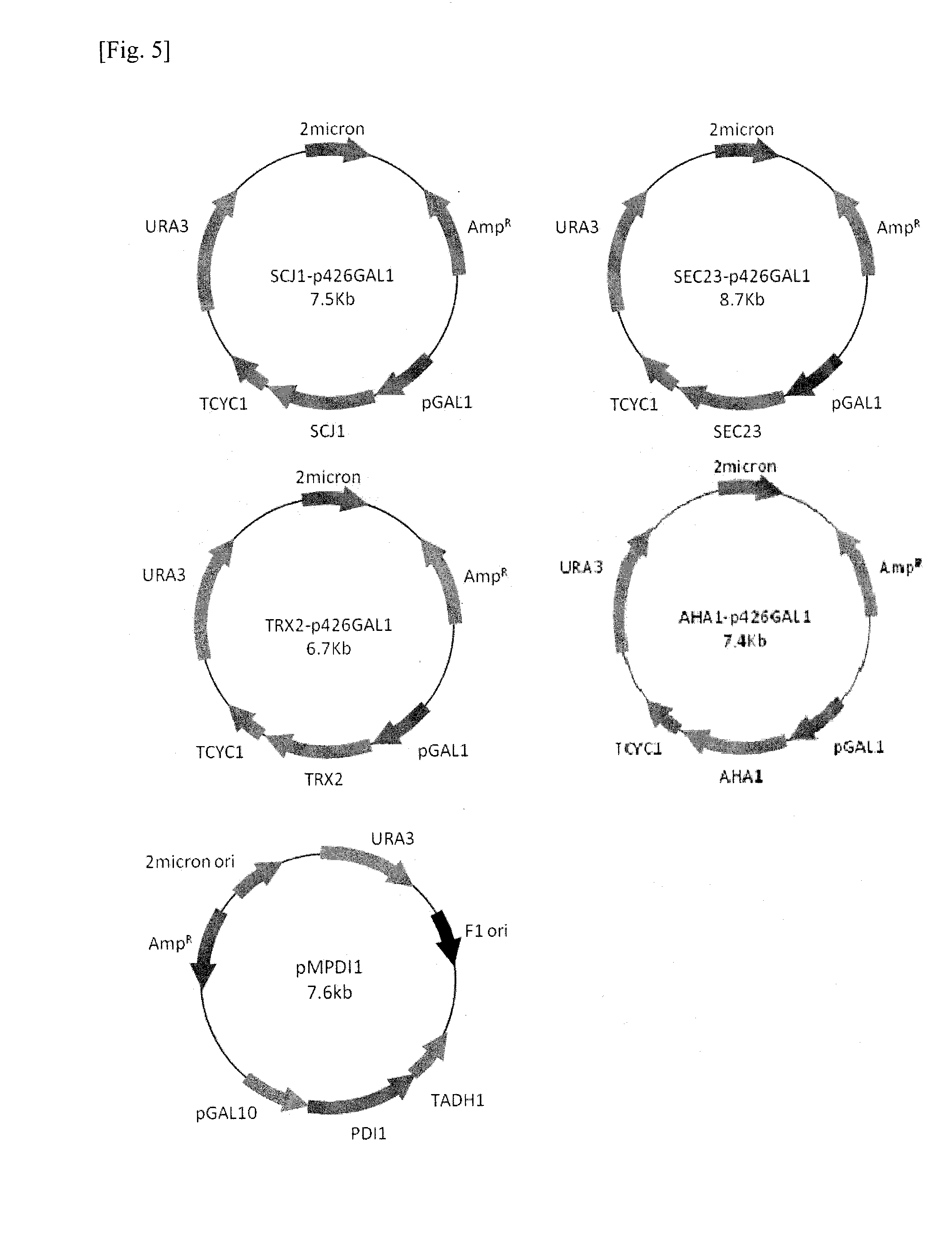Method for a production of a recombinant protein using yeast co-expression system
a technology of co-expression system and recombinant protein, which is applied in the direction of isomerase, hydrolase, fermentation, etc., can solve the problem that yeast inherently exhibits lower protein expression levels
- Summary
- Abstract
- Description
- Claims
- Application Information
AI Technical Summary
Benefits of technology
Problems solved by technology
Method used
Image
Examples
example 1
Gene Expression Profiling of Relevant Genes
[0068]Effects of HBsAg expression on the S. cerevisiae genome were analyzed by monitoring quantitative gene expression patterns through DNA microarray. The strains used in this study are S. cerevisiae 2805 and S. cerevisiae 2805 / MδCL-HBs. The cell was harvested at 24, 48 hr in the culture (FIG. 2) and the RNA was purified. The expression profiling was measured by using the custom-ordered microarray chip (CombiMatrix Corp, USA) being composed of 600 interested genes. Among the genes tested, only genes showing a change of level of RNA more than two-fold comparing the host S. cerevisiae 2805 were selected (FIG. 3) for the next co-expression experiments.
example 2
Effects of Co-Expression of Protein Folding Accessories
[0069]To examine the effects of co-expresssion of folding accessory proteins on HBsAg production, S. cerevisiae 2805 / MδCL-HBs was transformed with plasmids harboring the genes coding folding accessory proteins using the lithium cesium acetate method. As the HBsAg, PDI1, SEC23, TRX2, SCJ1, AHA1 encoding genes are located behind the GAL1 or GAL10 promoter, their expression are simultaneously induced by galactose (FIG. 4, 5). All transformants were selected on YNB solid medium without uracil and with 1 g / L G418 sulfate.
[0070]Immunoblot assay (FIG. 6) was performed to assess the effect of chaperone co-expression on the production of HBsAg. As a result, PDI1, SEC23, TRX2 co-expression seemed to make a profound effect on HBsAg production. Co-expression of the three folding proteins enhanced the total HBsAg expression level by about 2-fold compared with the S. cerevisiae system expressing HBsAg only, respectively (Table 3). But AHA1 an...
example 3
Combinatorial Co-Expression of Protein Folding Accessories
[0071]To examine the synergistic effect of coexpresssion of folding accessory proteins on HBsAg production, 4 kinds of combinations were used among PDI1, SEC23, TRX2. For using the combinations, 3 plasmids were constructed additionally (FIG. 7).
[0072]Co-expression of the PT (PDI1+TRX2) and PS (PDI1+SEC23) combination showed total HBsAg expression levels of 31.8 and 26.3 mg / L which were 2.5 and 2.1 times higher than without co-expression, respectively (Table 4). And 3 types of HBsAg band in immunoblot assay were also observed like those of single chaperone co-expressions. In the case of the ST (SEC23+TRX2) and PST (PDI1+SEC23+TRX2) combination did not show a remarkable increase in HBsAg expression level. And a very low-level of cell growth was observed in PST combination. But PT (PDI1+TRX2) and PS (PDI1+SEC23) combinations enhanced the expression level of HBsAg.
TABLE 4Effects of combinatorial expression of proteinfolding acces...
PUM
| Property | Measurement | Unit |
|---|---|---|
| concentration | aaaaa | aaaaa |
| concentration | aaaaa | aaaaa |
| concentration | aaaaa | aaaaa |
Abstract
Description
Claims
Application Information
 Login to View More
Login to View More - R&D
- Intellectual Property
- Life Sciences
- Materials
- Tech Scout
- Unparalleled Data Quality
- Higher Quality Content
- 60% Fewer Hallucinations
Browse by: Latest US Patents, China's latest patents, Technical Efficacy Thesaurus, Application Domain, Technology Topic, Popular Technical Reports.
© 2025 PatSnap. All rights reserved.Legal|Privacy policy|Modern Slavery Act Transparency Statement|Sitemap|About US| Contact US: help@patsnap.com



